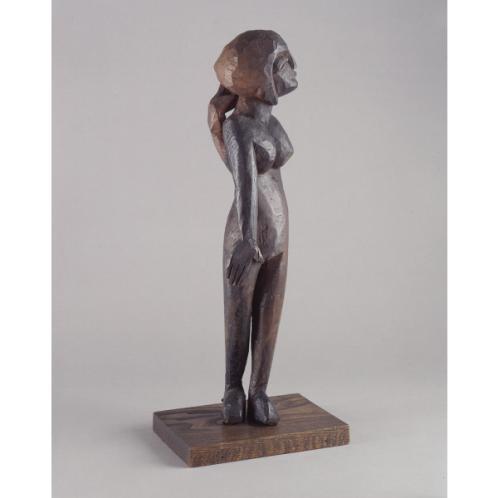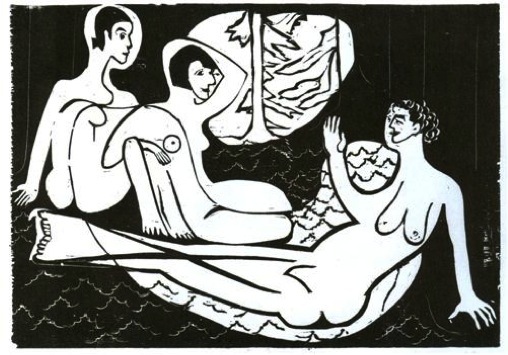Ernst Ludwig Kirchner was the leader of The Bridge from the time it was founded in 1905. Before that in 1901, Kirchner finished school and went to Dresden to study architecture. There, he began working on woodcuts, lithographs, and paintings, developing an expressionistic style with characteristic angular and elongated forms. Like the other members of the Bridge, Kirchner was fascinated by non-Western art and sought to emulate it. In his Standing Nude, Kirchner works with the medium of wood to investigate the primitivist nude in sculpture. This allows him to interact with the subject in three-dimensions, rather than painting scenes in his workshop from models and imagination. While Pechstein and Müller’s paintingsseem to have been contrived in a studio setting, Kirchner looks outside of the studio towards African and Oceanic art for this sculpture, and he imagines this woman and her pose.
Kirchner began creating wooden sculptures such as The Standing Nude at the St. Louis Art Museum, which he produced in 1913. He stated in his journal, "There is a figure in every trunk, one must only peel it out."[1] For this particular sculpture, Kirchner used a piece of oak as his medium. The wall text at the Saint Louis Art Museum speculates that this was a piece of driftwood he had found while visiting Fehmarn, an island in the Baltic Sea. The use of this natural material is a similar technique to Müller’s use of burlap. These natural materials indicate a sense resourcefulness, an attribute of non-Western art that the Bridge artists admired. Kirchner wrote in 1912 describing Fehmarn as, “a wonderful coast…fabulous flowers with fleshy stems and in addition a rather degenerate population due to intermarriage.”[2] The wood material itself in Kirchner’s sculpture is rendered in a rough-hewn style. The finish is neither polished, nor sophisticated, but rather, it is textured and jarring. This is symbolic of how Kircher saw the people of Fehmarn and his complicated relationship with the place. He wanted to immerse himself in it, becoming a part of it, but he also had a negative and stereotypical image of the people there, thinking himself superior.
While academic artists of the time were still looking to Greco-Roman sculpture as the ideal form of beauty with curvature and rendered in materials like marble, Kirchner chooses to portray a rectilinear woman in a rough form with wood, as did Gauguin in his sculptures. The figure is more of an embodiment primitivism than a naturalistic portrait of a real woman. Kirchner stated in a journal that he wanted his wood sculptures to have a “dreamlike” effect to present a narrative within a single figure.[3] In addition, the figure’s face has a masklike quality, which is indicative of the Oceanic art he was studying at the Dresden Museum of Ethnology. The mask is an allusion to non-Western peoples, who the Bridge saw as one with their natural environment.
The form of the sculpture is simplified and geometric, using a linear structure rather than emphasizing the curves of the body. Her arms and legs lay straight without natural curvature at the joints. She stands in a slightly twisted pose, turning her upper body. Her left arm seems to be pulled back behind her and she faces upward, as if towards the sky. As scholar of German Expressionism Jill Lloyd notes, “Kirchner and his companions drew on the regenerative associations of the primitive and the rejuvenating forces gained from a vital and direct confrontation with nature.”[4] That is exactly what the figure seems to be doing. It looks as though she has seen a bird flying above her, or she is feeling the sun on her face in a breeze that pushes against her stance.
Kirchner was also interested in producing the primitivist nude in different media, like woodcut. In his print Three Nudes in the Forest,1933,he uses similarly simplified figures to his wood sculpture, yet he places them in a forest setting. The figures here almost resemble mermaids, their legs coming together into one figure as they seem to perch on the land in the trees. These figures poses look as though Kirchner situated them in a studio. Kirchner creates a narrative through setting, rather than through the pose and medium. Both works, however, are representative of Kirchner “fusing man and nature into a single entity by means of open contours.”[5]
Kirchner’s Standing Nude shows how the medium can influence the form and make aesthetic connections between theme and material. The wooden sculpture gives the impression that it was quickly yet skillfully rendered, and the figure’s pose emulates the sun-worshipping pose that Kircher was interested in recreating. In these ways, Kirchner depicts facets of the primitivist nude that all the Bridge members created. She is a woman close to nature, with long, rectilinear features and a masklike face. Kirchner shows an admiration, but also a stereotypical view of the women on the island of Fehmarn.
[1] "Saint Louis Art Museum: Collections." Saint Louis Art Museum: Collections. Web.
[2] Jill Lloyd. German Expressionism. (New Haven: Yale University Press, 1991), 125.
[3] Lucius Grisebach. "Kirchner, Ernst Ludwig." Grove Art Online. Oxford Art Online, (Oxford University Press). Web.
[4] Jill Lloyd. German Expressionism. (New Haven: Yale University Press), 1991, 116.
[5] Jill Lloyd. German Expressionism. (New Haven: Yale University Press, 1991), 125.

